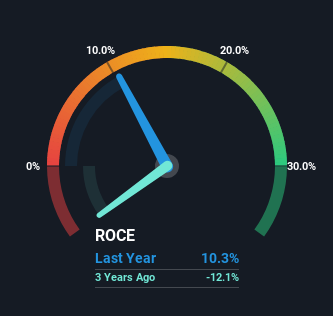- India
- /
- Auto Components
- /
- NSEI:SETCO
Investors Could Be Concerned With Setco Automotive's (NSE:SETCO) Returns On Capital
When researching a stock for investment, what can tell us that the company is in decline? More often than not, we'll see a declining return on capital employed (ROCE) and a declining amount of capital employed. This indicates the company is producing less profit from its investments and its total assets are decreasing. On that note, looking into Setco Automotive (NSE:SETCO), we weren't too upbeat about how things were going.
Understanding Return On Capital Employed (ROCE)
For those who don't know, ROCE is a measure of a company's yearly pre-tax profit (its return), relative to the capital employed in the business. The formula for this calculation on Setco Automotive is:
Return on Capital Employed = Earnings Before Interest and Tax (EBIT) ÷ (Total Assets - Current Liabilities)
0.10 = ₹361m ÷ (₹5.6b - ₹2.1b) (Based on the trailing twelve months to December 2023).
Therefore, Setco Automotive has an ROCE of 10%. In isolation, that's a pretty standard return but against the Auto Components industry average of 15%, it's not as good.
See our latest analysis for Setco Automotive

While the past is not representative of the future, it can be helpful to know how a company has performed historically, which is why we have this chart above. If you want to delve into the historical earnings , check out these free graphs detailing revenue and cash flow performance of Setco Automotive.
So How Is Setco Automotive's ROCE Trending?
In terms of Setco Automotive's historical ROCE movements, the trend doesn't inspire confidence. Unfortunately the returns on capital have diminished from the 18% that they were earning five years ago. Meanwhile, capital employed in the business has stayed roughly the flat over the period. This combination can be indicative of a mature business that still has areas to deploy capital, but the returns received aren't as high due potentially to new competition or smaller margins. So because these trends aren't typically conducive to creating a multi-bagger, we wouldn't hold our breath on Setco Automotive becoming one if things continue as they have.
On a related note, Setco Automotive has decreased its current liabilities to 37% of total assets. That could partly explain why the ROCE has dropped. Effectively this means their suppliers or short-term creditors are funding less of the business, which reduces some elements of risk. Some would claim this reduces the business' efficiency at generating ROCE since it is now funding more of the operations with its own money.
What We Can Learn From Setco Automotive's ROCE
In summary, it's unfortunate that Setco Automotive is generating lower returns from the same amount of capital. Unsurprisingly then, the stock has dived 76% over the last five years, so investors are recognizing these changes and don't like the company's prospects. With underlying trends that aren't great in these areas, we'd consider looking elsewhere.
Since virtually every company faces some risks, it's worth knowing what they are, and we've spotted 3 warning signs for Setco Automotive (of which 2 are significant!) that you should know about.
If you want to search for solid companies with great earnings, check out this free list of companies with good balance sheets and impressive returns on equity.
New: Manage All Your Stock Portfolios in One Place
We've created the ultimate portfolio companion for stock investors, and it's free.
• Connect an unlimited number of Portfolios and see your total in one currency
• Be alerted to new Warning Signs or Risks via email or mobile
• Track the Fair Value of your stocks
Have feedback on this article? Concerned about the content? Get in touch with us directly. Alternatively, email editorial-team (at) simplywallst.com.
This article by Simply Wall St is general in nature. We provide commentary based on historical data and analyst forecasts only using an unbiased methodology and our articles are not intended to be financial advice. It does not constitute a recommendation to buy or sell any stock, and does not take account of your objectives, or your financial situation. We aim to bring you long-term focused analysis driven by fundamental data. Note that our analysis may not factor in the latest price-sensitive company announcements or qualitative material. Simply Wall St has no position in any stocks mentioned.
About NSEI:SETCO
Setco Automotive
Manufactures and trades in clutches and other automotive components in India and internationally.
Good value with low risk.
Market Insights
Community Narratives




